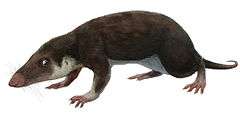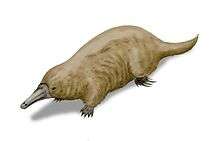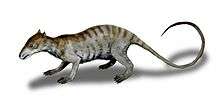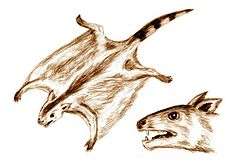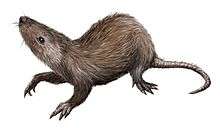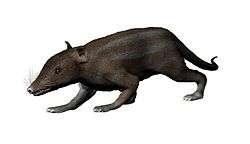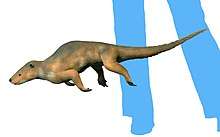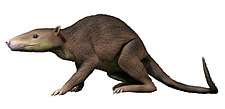Paulchoffatiidae
Paulchoffatiidae is a family of extinct mammals that lived predominantly during the Upper Jurassic period, though a couple of genera are known from the earliest Cretaceous. Some undescribed fossils from the Middle Jurassic of England may represent earlier versions. Remains have been reported from Portugal, Spain and England. Paulchoffatiids were members of the order Multituberculata. They were relatively early representatives and are within the informal suborder of "Plagiaulacida". The family was named by G. Hahn in 1969, and it honors the Portuguese geologist Léon Paul Choffat. Two subfamilies are recognized.
| Paulchoffatiidae Temporal range: Jurassic-Cretaceous | |
|---|---|
| Scientific classification | |
| Kingdom: | Animalia |
| Phylum: | Chordata |
| Class: | Mammalia |
| Order: | †Multituberculata |
| Suborder: | †Plagiaulacida |
| Family: | †Paulchoffatiidae |
| Genera | |
The most productive fossil site for Paulchoffatiids has been Guimarota, Portugal. Remains from this locality are generally diagnosed on the basis of lower or upper jaws. In only one instance, that of Kuehneodon, has it been possible to match the two up. Some of the lower jaws probably represent the same animals as some of the upper, so the diversity of Paulchoffatiids is very possibly exaggerated. As the site is now a flooded, disused coalmine, further excavations are highly unlikely. However, other locations may yet provide more clarity.
The Paulchoffatiids have been further arranged into two subfamilies and a couple of other genera.
Subfamily Paulchoffatiinae
Paulchoffatia, Bathmochoffatia, Guimarotodon, Henkelodon, Kielanodon, Meketibolodon, Meketichoffatia, Plesiochoffatia, Pseudobolodon, Galveodon, Sunnyodon, Xenachoffatia
Subfamily Kuehneodontinae
This taxon is restricted to one genus, Kuehneodon, with seven species.
Taxonomy
Subclass †Allotheria Marsh, 1880
- Order †Multituberculata Cope, 1884:
- Suborder †Plagiaulacida Simpson 1925
- Family †Paulchoffatiidae Hahn, 1969
- Subfamily †Paulchoffatiinae Hahn, 1971
- Genus †Paulchoffatia Kühne, 1961
- Species †P. delgadoi Kühne, 1961
- Genus †Pseudobolodon Hahn, 1977
- Species †P. oreas Hahn, 1977
- Species †P. krebsi Hahn & Hahn, 1994
- Genus †Henkelodon Hahn, 1987
- Species †H. naias Hahn, 1987
- Genus †Guimarotodon Hahn, 1969
- Species †G. leiriensis Hahn, 1969
- Genus †Meketibolodon (Hahn, 1978) Hahn, 1993
- Species †M. robustus (Hahn, 1978) Hahn, 1993
- Genus †Plesiochoffatia Hahn & Hahn, 1999
- Species †P. thoas Hahn & Hahn, 1998
- Species †P. peparethos Hahn & Hahn, 1998
- Species †P. staphylos Hahn & Hahn, 1998
- Genus †Xenachoffatia Hahn & Hahn, 1998
- Species †X. oinopion Hahn & Hahn, 1998
- Genus †Bathmochoffatia Hahn & Hahn, 1998
- Species †B. hapax Hahn & Hahn, 1998
- Genus †Kielanodon Hahn, 1987
- Species †K. hopsoni Hahn, 1987
- Genus †Meketichoffatia Hahn, 1993
- Species †M. krausei Hahn, 1993
- Genus †Galveodon Hahn & Hahn, 1992
- Species †G. nannothus Hahn & Hahn, 1992
- Genus †Sunnyodon Kielan-Jaworowska & Ensom, 1992
- Species †S. notleyi Kielan-Jaworowska & Ensom, 1992
- Genus †Paulchoffatia Kühne, 1961
- Subfamily †Kuehneodontinae Hahn, 1971
- Genus †Kuehneodon Hahn, 1969
- Species †K. dietrichi Hahn, 1969
- Species †K. barcasensis Hahn & Hahn, 2001
- Species †K. dryas Hahn, 1977
- Species †K. guimarotensis Hahn, 1969
- Species †K. hahni Antunes, 1988
- Species †K. simpsoni Hahn, 1969
- Species †K. uniradiculatus Hahn, 1978
- Genus †Kuehneodon Hahn, 1969
- Subfamily †Paulchoffatiinae Hahn, 1971
- Family †Paulchoffatiidae Hahn, 1969
- Suborder †Plagiaulacida Simpson 1925
References
- Hahn G. and Hahn R. (2000), Multituberculates from the Guimarota mine, p. 97-107 in Martin T. and Krebs B. (eds), Guimarota - A Jurassic Ecosystem, Published by Dr Friedrich Pfeil in Münich, Germany.
- Kielan-Jaworowska Z. and Hurum J.H. (2001), "Phylogeny and Systematics of multituberculate mammals". Paleontology 44, p. 389-429.
- Much of this information has been derived from MESOZOIC MAMMALS; Basal Multituberculata, an Internet directory.
